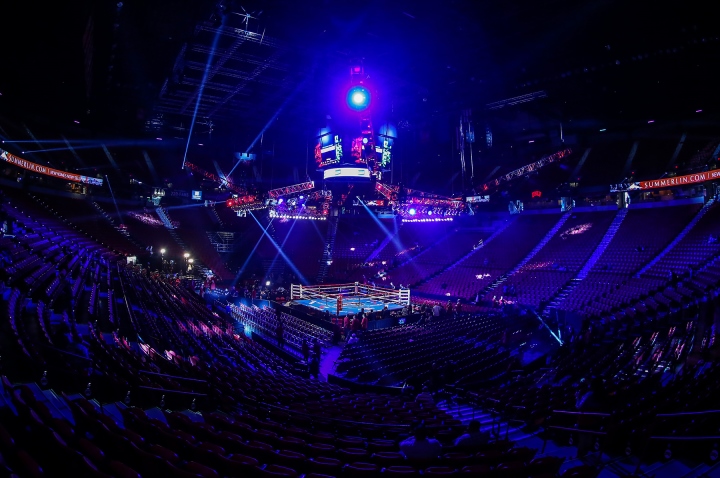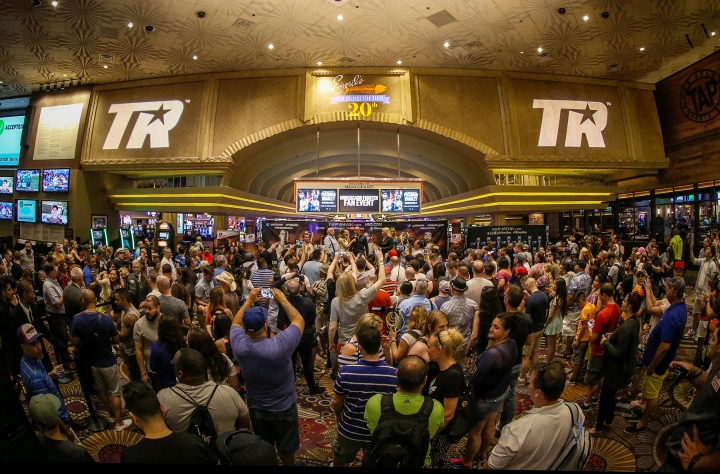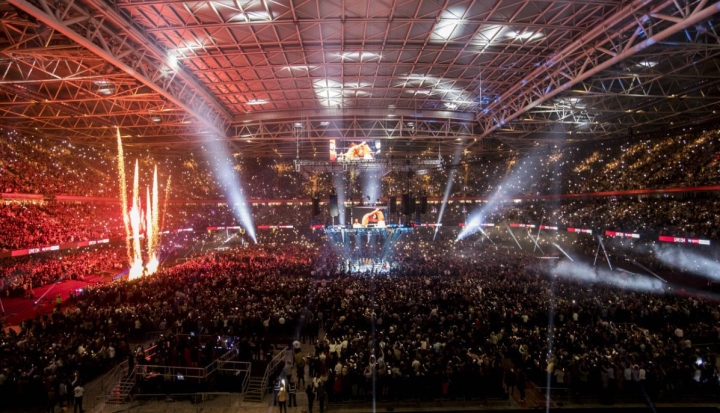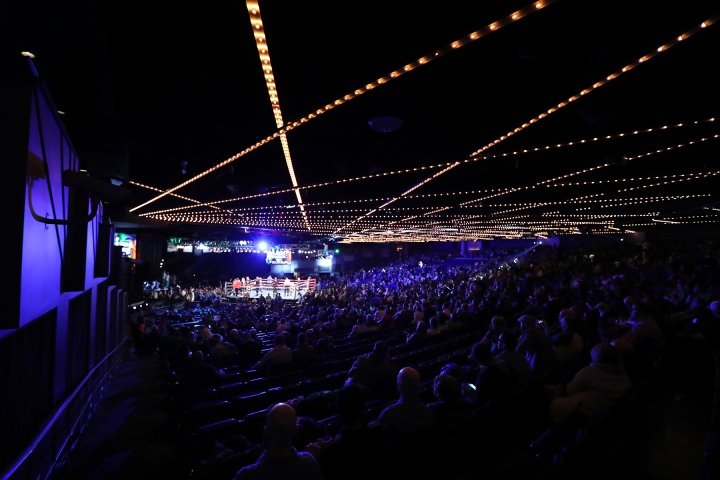By Jake Donovan
Even in an era largely dominated by the Fab Four, you couldn’t grow up as a boxing fan in the 1980s and not have been infatuated with Hector ‘Macho’ Camacho, Sr.
Career-wise, it’s been a couple of years since anyone has last seen even the shell of the former superstar in the ring.
Sadly, the last time he was seen alive and well (relatively speaking) by anyone at all was on November 20, 2012.
That was the night Camacho was shot in the face and in critical condition, a status for which his family now longs. He was marginally more fortunate than his friend seated next to him. Adrian Mojica Moreno, 49, was killed instantaneously in the attack.
The former superstar was declared brain dead two days later, on Thanksgiving day. The only fight left in the past few days was among his family, with a split decision in favor of leaving him on life support at least through the holiday, according to reports coming from Puerto Rico.

Camacho’s father opted to allow nature to play its course after the doctors informed the family that there was nothing left to be done. His request was overruled by Camacho’s sisters, a decision reluctantly agreed upon by remaining family members.

“I’m a person of a lot of faith, and I believe in miracles. But science has spoken,” Aida Camacho, an aunt of the former three-division champ, told the Associated Press.

Her sentiment mirrored that of another aunt, Blanca Camacho, who acquiesced to her nieces’ request despite the admittance that “there’s nothing left here. He’s already dead.”

Camacho, whose career ended two years ago with a record of 79-6-3 (38KO), was taken off life support early Saturday morning. He was 50 years old.

Now it’s time for the memories to live on.

There was a time when Camacho was thought to possess the potential to become one of the very best of all time. A perfect blend of speed, power and charisma, Camacho had all of the necessary tools to become boxing’s premiere little big man.

Based solely on pure talent, you could contend that Camacho was Roy Jones a decade before Jones came along. Add in the bad boy factor, and it’s not farfetched to suggest that he was Mike Tyson a few years before the real thing came along to rescue a nearly forgotten heavyweight division.

Imprisoned at 15, a father by age 16, Camacho led a wild life before even hitting the amateur ranks. As was the case with so many, boxing was meant to be his escape from the violent surroundings of the streets of Spanish Harlem, to where his family moved from San Juan during his youth.

Camacho’s introduction to the sport may sound familiar, but it’s where the similarities end.

By the time he was ready for his first title shot, “Macho Time” was already a household phrase. He was already as identifiable by his trademark S-curl gracing the center of his forehead and his “MACHO” nameplate as he was celebrated for the dynamic boxing style on display every time he stepped into the ring.

Faded former champ Rafael ‘Bazooka’ Limon was the first to get a taste of vintage Macho Time, the answer to the trivia question of whom Camacho beat for his first major title. Limon was served up only because he was willing to do what previous conqueror Bobby Chacon wasn’t – travel to Puerto Rico to face the then-unbeaten 21-year old rising star for a vacant 130 lb. crown.

The fight wasn’t just Camacho’s first title shot, but also his first fight against anyone who’d ever held a belt. The flashy southpaw rose to the occasion, dominating every second of the fight and scoring two knockdowns before forcing a stoppage towards the end of the fifth round.

It was officially Macho Time.
Camacho was hardly the first Puerto Rican to make it big, but his larger than life personality and bilingual tongue allowed for crossover appeal not afforded to several past Boricua greats. He was celebrated in Puerto Rico. He was celebrated in New York, and the new face of “Nuyoricans”.

He was also a hero to those forced to survive every day street life, one who rose from crime and violence to make it to the big time.

But to paraphrase a famous saying, you can take the man out of the ‘hood, but you can’t take the ‘hood out of the man.

The moment that perhaps best encapsulates Camacho’s upbringing was his infamous interview with HBO’s Larry Merchant following a decision win over Jose Luis Ramirez in Aug. ’85. The win earned him the lightweight title, making him a two-division champion by age 23 and in the span of just two years.

Simply put, Camacho was on top of the world. There was never a dull moment in the ring or in the moments immediately following. Political correctness was lost on Camacho, who remained unfiltered until his final days on Earth. A slew of titlists and rising young fighters were on his hit list, even going so far as to call out the reigning heavyweight champion of the world.

In his own words:
“(Ray) Mancini, I don’t respect your opinion. Come get some baby, so I can knock YOU out. Pernell Whitaker, you can come get some. Livingston Bramble, Jimmy Paul… Larry Holmes, all y’all niggas. Come on with it!”

A young(er) color commentator by the name of Larry Merchant was on the other end of the mic, allowing for a long pause before continuing with the interview. The dropping of the N-bomb caught the attention of many, particularly uppity white corporate executives who failed to understand the term in its proper context. In most circles, it was a deplorable statement that drew the ire of many.

To those who could empathize with Camacho’s upbringing, it was mere slang. It was the confidence of a man feeling the moment and daring the world to knock him off his perch.

As his career would play out, that moment turned out to be the height of Macho Time. Two fights later, he ran into fellow Boricua lightweight Edwin Rosario at Madison Square Garden. If the fight had taken place today, Rosario would have been praised for his aggression and the final decision would have been lustily booed.

The truth is that Camacho deserved the win, but took a beating from Rosario that in effect took a chunk of his prime and forever changed the way he fight.

A long awaited showdown with Mancini would finally surface, only it came four years past its sell date and turned out to be a letdown in terms of action. Still, it commanded major attention and the split decision win earned Camacho a major title in his third weight class, winning a 140 lb. belt, which he successfully defended with wins over Vinny Pazienza and Tony Baltazar a year later.

All told, Camacho remained unbeaten for another five years following the Rosario fight. In between Rosario and Mancini came landslide wins over Cornelius Boza-Edwards and Howard Davis. None of the other cats Camacho called out in the moments after the Ramirez fight ever surfaced. Whitaker was only a year into his career at the time, while Bramble and Paul remained hesitant on the idea of unifying against the motor-mouthed champ.
The first in-ring loss came in the first of two fights with Greg Haugen in 1991. Camacho struggled to make the 140 lb. limit, but still nearly escaped with his unbeaten record still intact. A 12th round point deduction for unsportsmanlike conduct proved to be the difference between a split decision loss and what would have been a draw.
Haugen tested positive for marijuana after the first fight, prompting a rematch and a fine, but no suspension or nullifying of the result. Camacho gained revenge and his alphabet title, the last time he would ever post a win in a championship fight.
From there, Macho Time was limited to a supporting act, lending his name to promotions rather than serving as the star attraction.
The first fight on that tour came against Julio Cesar Chavez in Sept. ’92. The event proved to be a huge success – for a while, it was the highest selling non-heavyweight pay-per-view event of all time.
What the fight wasn’t - was competitive. Chavez dished out a beating on the moments in which Camacho didn’t fight in retreat mode. It almost seemed personal to Chavez at the time, though any grudge he may have held ended the moment the final bell sounded.
“It’s sad what happened to Camacho. The truth is, he was a great friend, even though we were rivals and there was a great rivalry between Puerto Rico and Mexico, “Chavez recently said in mourning the loss of Camacho. “He's one of the best boxers of all time. He revolutionized boxing. He was very charismatic and controversial, talkative, but very good, very fast.
“As a person he was outgoing, talkative, but unfortunately he got into a lot of trouble because his personality. The only thing I can say is that we are great friends. After the fight there were always signs of affection and appreciation. We hugged and he is a great person.”
Other opponents didn’t necessarily share that opinion at the time they fought Camacho.
Felix Trinidad was a young titlist at the time he faced his countryman in Jan. ’94. When asked to make a list of the greatest fighters in the history of Puerto Rico, Trinidad didn’t bother to list the former three-division champ, nor did he seem to care for him at any point in the promotion.
Camacho sold a good game, but was uncompetitive in losing nearly every round. More of the same came nearly four years later, when he faced then-unbeaten Oscar de la Hoya.
The journey to de la Hoya came with wins over faded former Fab Four stars Roberto Duran and Sugar Ray Leonard. Camacho was actually handpicked as the opponent of choice for Leonard during his ill-advised comeback in 1997 following a five-year hiatus. The move proved disastrous as Camacho humiliated the badly faded all-time great en route to a fifth round knockout and re-retirement.
Against de la Hoya, Camacho was at his least competitive. Not only did he lose in lopsided fashion, but suffered a knockdown and was forced to embarrassingly squeal his way out of a side bet after originally offering to cut off his S-curl had he lost the fight.
It was the last time Camacho would fight for a major title or in a significant fight of any kind, unless you count the rematch with Duran in July ’01. The lone redeeming quality to come of the win was that it came a week after his son, Hector Jr., was exposed for his lack of fighting heart in an HBO-televised bout with Jesse James Leija.
Still, Camacho managed to remain in the public eye despite fighting only sparingly over the course of the past decade. Far too often, his name graced the headlines for all of the wrong reasons. But almost as often, he could be spotted at ringside for random events, causing an instant traffic jam as he always stopped to sign autographs and pose for pictures.
The truth is that both sides defined Camacho. He never found a way to escape the lifestyle that included drugs, partying and crime sprees. Perhaps it was due to his achieving too much too soon in life, serving as one of the greatest fighters in the world at just 21 years old and remaining on top for several years even while still entering manhood.
Even when you take into account the tragic details that led to his final moments on Earth, chances are Hector Camacho Sr. wouldn’t change a word of the script if you asked him to do it all over again.
The life he chose to lead far too often ends in such tragic fashion. But the times he enjoyed in his full glory, will forever be remembered as Macho Time.
Jake Donovan is the Managing Editor of Boxingscene.com. Follow Jake on Twitter: @JakeNDaBox

